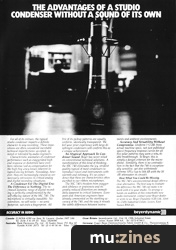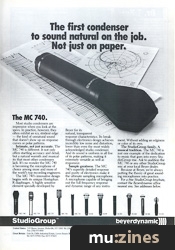Magazine Archive
Home -> Magazines -> Issues -> Articles in this issue -> View
Beyer MC740 | |
Condenser MicrophoneArticle from Sound On Sound, November 1989 | |
Good quality microphones can be a real asset to any type of studio, but if you want the best tools you should be prepared to pay the price for them. Gareth Stuart considers the worth of Beyer's top of the range condenser mic.

The need, or pressure, to constantly upgrade studio equipment can present quite a dilemma if you are working within very tight budget restrictions. There can come a point when you simply have to stop spending money and invest time to realise the full potential of your current set-up. Given technological advances, the sounds now produced by most major manufacturers' MIDI instruments are so crystal clear and bright that they tend to put to shame any acoustic tracks which have not been recorded with half decent microphones; and by that I mean good quality condenser mics. But is there any point in buying an expensive microphone if your mixing desk or other equipment in the audio chain isn't up to scratch?
Obviously, the answer depends on what you are upgrading from: a leap from a cheap £70 dynamic mic to a top quality condenser such as this Beyer MC740 (at £850 plus VAT) should yield a vast improvement regardless of your equipment's inadequacies, but what about moving (up?) from an AKG 414, Neumann U87, or Sennheiser MKH40 - all good quality mics at half the price (excepting the Neumann U87)?
Tricky, isn't it? A fundamental point which you should consider is whether to choose a mic which has been designed to give a totally uncoloured and neutral sound, or a mic which 'sounds' good - ie. one that, for whatever technical reason, shortcoming or design feature, in some way colours the signal in such a way that it produces a definable sound of its own.
In previous microphone reviews my comparisons have always been made against an AKG 414 (1986 model), which is a good quality middle of the range condenser mic that I own and use regularly. It boasts a ruler flat frequency response from 20Hz-20kHz but falls down against newer mics in the areas of self-noise and signal-to-noise ratio, since most newer mics give a much higher output, and when compared for brightness against mics (like the MC740) which incorporate 'presence peaks' as an integral design feature. The frequency response of the Beyer MC740 has been designed to enhance vocal and instrumental 'presence' with a precisely contoured high end rise: specifically from 0dB at 4kHz to a +5dB plateau between 6-8kHz, rising to +8dB at 10kHz, and falling back to 0dB at around 18kHz. So what we have here, going on frequency response alone, is undoubtedly a bright mic.
The pros and cons of this approach versus the 'neutral' AKG ruler flat response are that the Beyer will save you having to boost the top end EQ (something I find myself doing as a matter of course with just about all AKG 414 studio work) but, on the downside, sibilance can become a problem for vocal work with the MC740 — especially if the signal is compressed, and you'll find a de-esser necessary to produce the optimum result.
VARIABLE PICKUP PATTERNS
Moving on, the MC740 offers a switchable selection of five polar patterns: cardioid, hyper-cardioid, figure-of-eight, omnidirectional, and wide cardioid. For most applications I appreciate how one might use the four commonest pickup patterns, but as to wide cardioid, I can only guess that this would fit the bill in situations where an omni type sound is required but with an amount of rejection at 180 degrees. I'm sure there must be other specific uses for this option, I'm just not aware of them. Despite this, five polar responses certainly offers bags of flexibility and should help make the MC740 most appealing to those recordists who don't currently own a wide range of quality microphones but have need of their services.
As you rotate the selector switch, the chosen polar response symbol is shown in a small recess on the body, located just behind the grille. Apart from these symbols an 'R' appears, though it's not clear from any of the documentation which comes with the mic what this stands for. It most likely means 'remote', for when the MC740's polar patterns are changed remotely using the optional MSG740 power supply. As it stands, when the 'R' is selected it produces a cardioid response - possibly the remote system's default setting. (Incidentally, should you require this option, ie. MC740 N(C/5), the mic comes with a 5-pin connector as opposed to the standard XLR.)
FIXED RESPONSE
One feature very much in the MC740's favour is its 'fixed' frequency response, regardless of which polar pattern is selected (or "independent of directional characteristic" as Beyer word it), which ensures a continuity of sound quality. The one pattern which you might expect to be most affected over the frequency spectrum is the omni setting, which under normal circumstances becomes more directional as the frequency rises. This is because all omnidirectional mics cease to be omnidirectional (ie. pick up sound equally all around the mic) at two to three octaves below the frequency at which sound wavelengths equal the microphone diameter. The Beyer's diaphragm is approximately 3cm across, and therefore you might expect it to start becoming directional above 1.5-3kHz. (Work it out for yourselves: the wavelength equals the speed of sound divided by the frequency. The wavelength here is 3cm and the speed of sound is 34000 cm/sec, so two to three octaves below that - ie. below 11.34kHz - is approximately 1.5kHz and 3kHz.) However, because of the "precisely contoured high end rise", the MC740's response remains perfectly omnidirectional up to 8kHz.
This is great for when the MC740 is used as a 'distant' omni - as in a pair of spaced omnis, but means extreme brightness for closely miked on-axis sounds. It might have been an idea to provide a low pass filter to compensate for this, but I suppose you can't have everything. The built-in filters it does provide are the more common high pass type, for rolling off excess bass frequencies at 80Hz and 160Hz. For most applications other than vocal recording this facility may not be needed, but for closely miked vocals in the cardioid position, they come in mighty handy in eliminating all popping and diminishing the bass accentuation created by the vocalist's proximity to the microphone. In addition to bass roll-off filters, there's a 10dB attenuation pad enabling the mic to handle sound pressure levels up to 144dB.
In order to change polar patterns, bass roll-off or the attenuation pad, it's necessary to rotate one of three dial switches which, due to their shallow profile, are rather awkward to turn. Come on Beyer, get a grip. I can appreciate that this may be an intended design feature to prevent accidental changes, but I found it unnecessarily fiddly.
That covers what the mic offers, now a few brief words as to its appearance. The MC740 is a fairly large affair, 215mm long, 37mm in diameter, weighing in at 390 grammes. It comes in a very smart plastic case and includes a standard microphone clip (MKV11) and an 'elastic transducer suspension system', or cradle (see photo), which certainly gives it that pro-studio mic look, but also serves to protect it from low frequency interference (as generated by a foot tapping on the mic stand, for example). However, for the majority of studio recording situations, I'd say that the standard clip is perfectly adequate.
SONIC PERFORMANCE
When heard flat, the AKG 414 sounds 'woolly' against the Beyer's designer brightness - but a little EQ tweaking soon overcomes the difference. It's here that golden ears make the critical difference between what microphone you finally opt for, because adding that extra EQ on the AKG 414 also boosts the noise generated by the mic itself. I found at this stage that my AKG 414 with EQ was a very reasonable substitute for a flat, unequalised MC740, but then perhaps my ears weren't hearing all they should, or my well worn Soundcraft desk was stifling the Beyer's true character. Perhaps it would have sounded different through a £50,000 DDA desk? (I'll let you know if I ever find out!) But seriously folks, the MC740 is extremely good - very clean and bright. I mentioned that it's a pretty hefty bit of kit, but unless you genuinely need small mics for unobtrusive live location work I can't see that being a problem. I found the design very pleasing and think it is quite refreshing to have a new approach, away from the traditional Neumann U87 and Sanken CU41 'look'.
FURTHER INFORMATION
£977.50 inc VAT.
Beyer Dynamic (GB) Ltd, (Contact Details).
Publisher: Sound On Sound - SOS Publications Ltd.
The contents of this magazine are re-published here with the kind permission of SOS Publications Ltd.
The current copyright owner/s of this content may differ from the originally published copyright notice.
More details on copyright ownership...
Gear in this article:
Microphone > Beyer Dynamic > MC 740
Gear Tags:
Condenser Mic
Cardioid
Hypercardioid
Omnidirectional
Figure-8
Wide Cardioid
Review by Gareth Stuart
Help Support The Things You Love
mu:zines is the result of thousands of hours of effort, and will require many thousands more going forward to reach our goals of getting all this content online.
If you value this resource, you can support this project - it really helps!
Donations for April 2024
Issues donated this month: 0
New issues that have been donated or scanned for us this month.
Funds donated this month: £20.00
All donations and support are gratefully appreciated - thank you.
Magazines Needed - Can You Help?
Do you have any of these magazine issues?
If so, and you can donate, lend or scan them to help complete our archive, please get in touch via the Contribute page - thanks!






